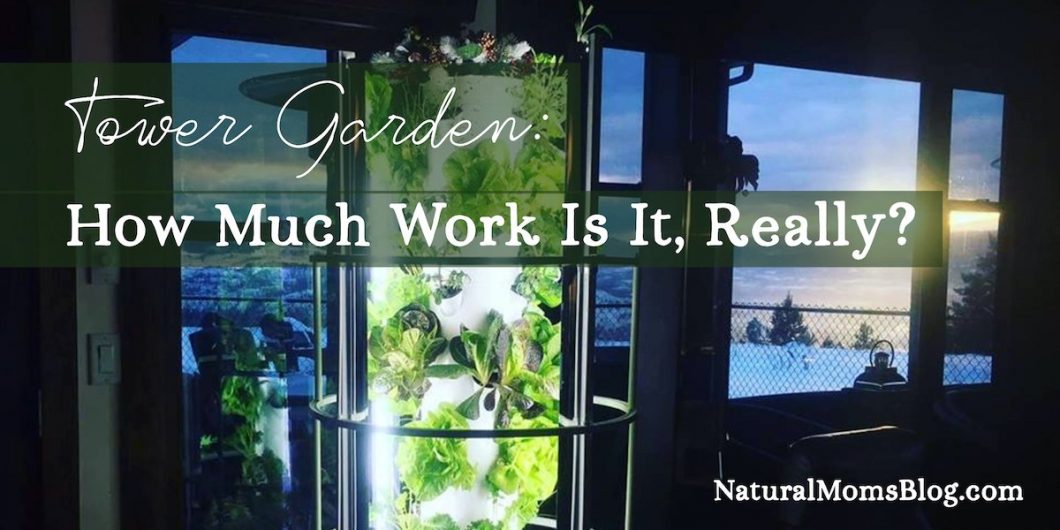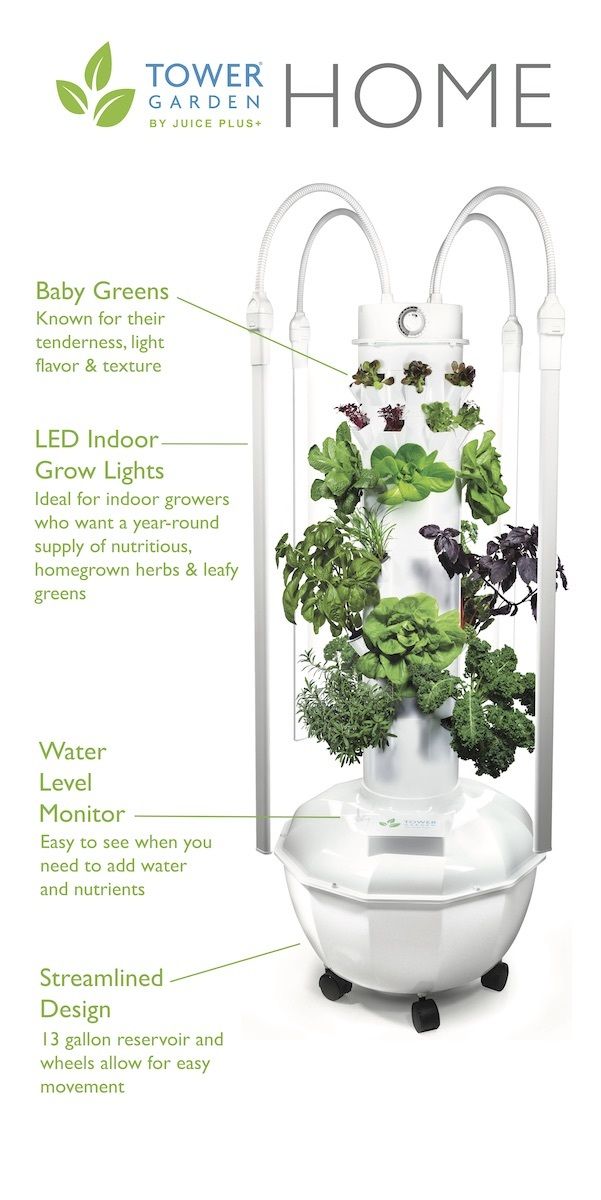- in Gardening by Alexis Rodrigo
- |
- 2 comments
How Much Work Is the Tower Garden? The 100% Honest Truth

You may have heard that growing with the Tower Garden Growing System is plug-and-play easy.
And as someone who grows food using both traditional gardening and Tower Gardening, I know first-hand how much easier the Tower Garden is.
But is it truly plug-and-play?
Can you really set it and forget it?
Here's the 100% honest truth: Not quite!
To be fair, it’s not sweat-inducing, back-breaking work like planting in the ground. But it’s not completely hands-off, either!
So, exactly how much work is involved in growing in the Tower Garden?
About 30 minutes a week.
Let’s break it down into the daily, weekly/bi-weekly, monthly, yearly, and periodic tasks involved in Tower Gardening.
Daily
Visit
Stop by and check on your plants every day. Once they start growing, believe me, you’ll want to do this anyway.
Not only is it fascinating and gratifying to see them growing. This is also the best way for you to catch any problems or potential issues before they become serious. Keep an eye out for holes, suspicious spots and speckles, mildew, webs, and other signs of pests and disease.
Tip: Many people with green thumbs, my mom included, swear by the power of talking to your plants.
Harvesting
Once your plants are ready, harvest often. This encourages them to grow more. With plants, the more you get, the more they’ll give.
Regular harvesting also keeps your plants healthy by making sure they don’t overshadow each other, and by maintaining good ventilation throughout your Tower Garden. This can prevent many diseases and even pests like gnats.
Rotation
If you have an outdoor Tower Garden and only one side of it receives adequate sunlight everyday, rotate the reservoir lid 1/4 turn in the same direction daily. This ensures that your plants grow uniformly.
You can also purchase a dolly for the Tower Garden Flex to make this job a lot easier. (The Tower Garden Home, on the other hand, has a built-in dolly.)
Bi-weekly or Weekly
To get the best results with your Tower Garden, you’ll want to perform these tasks weekly or bi-weekly:
Light Cleaning
The Tower Garden is like a piece of furniture that gathers dust. You’ll also see a bit of algae or mineral buildup in the seams of your Tower Garden. These look like white, salt-like residue.
They don’t hurt your plants but can (i.e., white, crusty residue) on your Tower Garden. Neither should affect the health of your plants, but they can be unappealing.
I’ve also read that dusty surfaces can attract pests like spider mites, so it’s always a great idea to keep your Tower Garden clean.
You can wipe down your Tower Garden with a damp microfiber cloth. For mineral buidup that has gotten hard, try scrubbing them with a wet toothbrush.
Water Level Check and Top-up
The water level in the Tower Garden’s reservoir will eventually go down due to evaporation. This happens much faster when it’s hot, so you may want to do this twice a week in the heat of summer. A Tower Garden full of large plants, fruiting crops, and other water-thirsty plants (like tomatoes) also need to be checked twice a week.
When topping up the water, make sure to add the appropriate amount of nutrients. Refer to the label on the Mineral Blend to determine how much of each blend to add.
You’ll need a half-dose, 10 mL of Mineral Blend A and 10 mL of Mineral Blend B, for every gallon of water, when:
- Your plants are still seedlings.
- The weather is warm.
Otherwise, the usual ratio is 20 mL of Mineral Blend A and 20 mL of Mineral Blend B for each gallon of water you’re adding.
Water Temperature Check
The water temperature should be between 65-85 degrees Fahrenheit. This is especially important if your Tower Garden is outdoors.
However, even indoors, your plants may suffer from heat stress if your Tower is beside a large window or glass doors (trust me, I learned this the hard way!).
If the water inside the reservoir is too hot, try the following:
- Place your Tower Garden Flex on a dolly, doormat, pallet or other surface to raise it off of the ground. This prevents the heat from transferring from the ground to the reservoir.
- Add frozen water bottles to the water reservoir. Keep extra bottles of frozen water in your freezer so you always have some on hand when the other bottles thaw.
- Move your Tower to a shaded area or provide some sort of canopy for it.
Pruning
Trim the leaves and stems off of large plants to make sure they’re not blocking the light off of smaller plants.
Also, while you have the water reservoir access open, do check for roots hanging down into the water. Pull these out of the reservoir to keep them out of the pump. If you let the roots grow freely, they may clog up and burn out the pump.
Monthly
Pump Cleaning
Clean the pump by unplugging it and pulling it out of the reservoir through the access port. Open the pump cover and rinse the filter under running water to get rid of any decomposed plant matter and other debris. Refer to the pump manual for details on how to remove the pump cover.
Shower Cap Cleaning
The shower cap is the top-most part of the Tower. This is where the water is pumped up before it trickles down to the plants below. To clean the shower cap, first unplug the pump and the LED indoor lights (if using). Pull the grow lights off. Use a toothpick to remove debris from the holes of the shower cap.
Every Six Months
General Cleaning
It’s a good idea to give your Tower Garden a big bath once a year! Outdoor Tower Gardeners do this at the end of each growing season, around the fall. If you grow indoors, you can do it anytime.
There are 3 main steps to deep cleaning your Tower Garden:
1. Drain and Disassemble
Use the drain pipe to pump all the water out of the reservoir. Unplug the pump and lights, then disassemble the Tower Garden. Place your plants in a shallow tub filled with water.
2. Soak and Scrub
Let the parts of the Tower Garden soak in a natural cleaning solution for a few minutes or overnight. Scrub all the parts, rinse, and wipe or air dry.
3. Rinse and Repeat
Rinse, re-assemble, and re-fill your Tower Garden. Smile knowing you won’t have to do this again until next year!
This article has more details about how to clean your Tower Garden.
As Needed
pH Level Check
I used to check the pH level every week, after topping up the water and minerals. But now that I've been using the Tower Garden for several years, I feel confident that a weekly pH check is not necessary. Instead, I watch my plants and let them tell me if the pH might be off.
Tim Blank, creator of the Tower Garden, says that the Tower Garden Mineral Blends are effective within a wide range of pH levels. Many experienced Tower Garden owners have also said they don’t use the pH tester anymore. Instead, they observe their plants to see if the pH needs adjusting.
The ideal pH level in the Tower Garden is between 5.5-6.5. pH. If the pH of the water in your Tower Garden is either too high or too low, then your plants will show symptoms or visual clues. These may include:
- stunting or wilting of leaves
- discoloration, yellowing, or brown spots on leaves
- blossom end rot in fruits
- sad-looking plants
If you think the plants in your Tower Garden are struggling, then go ahead and check the pH of the water. It only takes a few minutes!
This means there’s no need to be obsessive about maintaining the pH! Don’t worry about it too much. Just do it when you get the chance.
A pH with the testing kit is included in your Tower Garden, along with instructions for how to adjust the pH by using the included pH+ or pH-.
Other miscellaneous tasks
We’re not done yet! There are tasks you may have to do occasionally, such as:
- Training vining plants to grow on a trellis or Support Cage. These include tomatoes, squash, and green beans.
- Hand pollinating fruit-bearing plants that aren’t producing. Plants like cucumbers, peppers, squash, and tomatoes may need to be hand pollinated if you’re growing them indoors, or if you don’t get a lot of pollinators outdoors.
- Addressing pests and diseases. When you do have a pest or disease problem, you’ll have to do the needful to address them. This may involve spraying your plants with non-toxic solutions, trimming off affected leaves, and other tasks.
- Starting new seeds. Eventually, you'll have to replace the plants growing in Tower Garden. Or maybe you just want to try something new. Either way, you'll put new seeds in your germination kit (which that with your Tower Garden) and pop them into an empty pod when they're ready. (I've also simply sprinkled seeds into an empty rockwool cube straight in the Tower Garden.)
That’s it!
Whew!
As you can see, growing plants in the Tower Garden is not zero work.
But it’s a lot less work compared to the digging, tilling, weeding, mulching, and other back-breaking jobs involved in traditional in-soil gardening.
In just a few minutes every day — adding up to about 30 minutes a week (often less) — you’ll have a healthy and thriving vertical garden of fresh, clean food for you and your family.
The Bottom Line:
The effort that goes into growing thriving plants in the Tower Garden is not nothing. However, it's much less work than traditional in-soil gardening. While you do have to tend to your plants, with the Tower Garden, there's no weeding, digging, or mulching. The "work" is pleasant and can be performed by children, seniors, and physically challenged folks. AND you get to reap your rewards much faster than vegetable gardening in soil.
If you liked this post, submit your email address below to get new posts by email:

